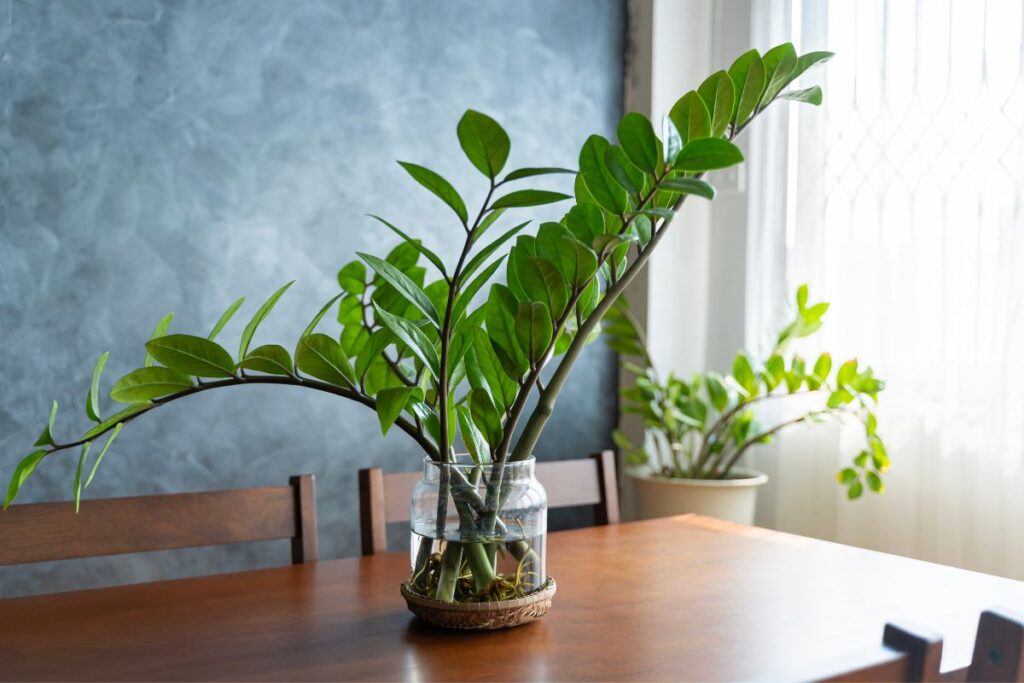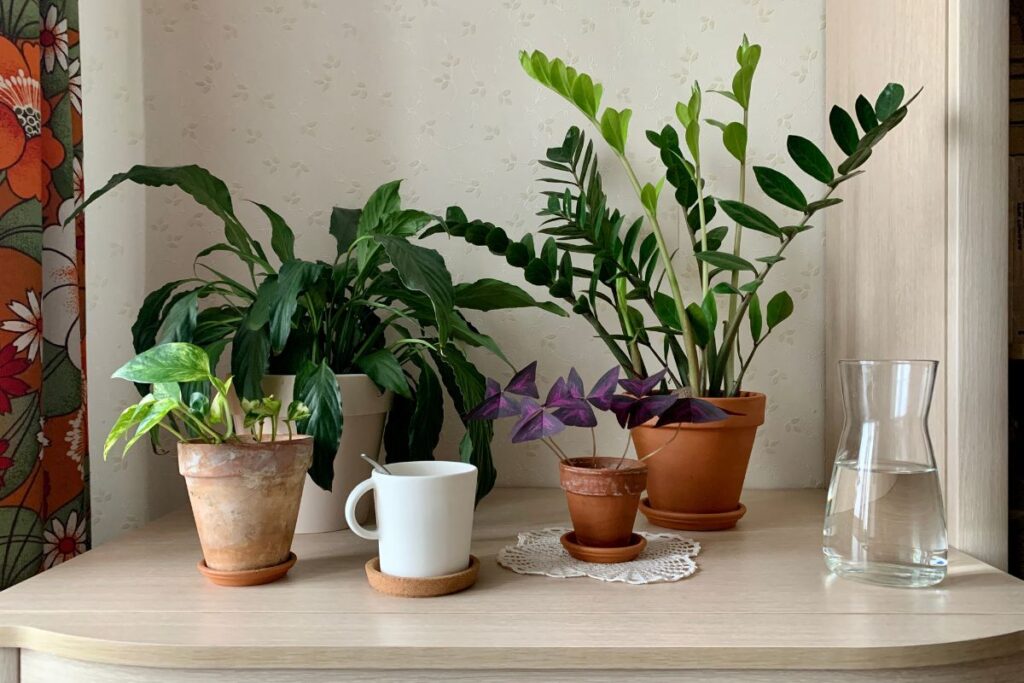Are you considering adding a ZZ Plant to your home, but not sure if it likes humidity? You’re in the right place! In this article, we’ll discuss how to determine the levels of humidity in your home and what signs to look out for that indicate your ZZ Plant may need more. We’ll also cover tips on how to increase the humidity of your plants. So keep reading and let’s get started!

Related Post:
25 Types Of ZZ Plants (With Pictures)
Contents
Do ZZ Plants Like Humidity?
You might be wondering if ZZ plants like humidity – the answer is yes! But don’t just assume that any placement will do for your new plant. For best results, consider how you can create an optimal environment with appropriate soil types, misting techniques, airflow and light conditions.
When it comes to placement for your ZZ plant, make sure it’s not in a room where there’s low humidity and poor air circulation. Avoid putting it near a window or heater as this could cause the leaves to dry out. The ideal location should be away from direct sunlight but in an area where there is enough natural light and good ventilation.
To ensure adequate moisture levels, use a potting mix designed for indoor plants and add some perlite or gravel to improve drainage. Ensure the container has plenty of holes at the bottom so the soil doesn’t become soggy due to excess water accumulation. Additionally, you can mist your ZZ plant occasionally to help keep its leaves hydrated as well as increase humidity levels in its immediate environment.
If you live in a particularly dry climate then these measures may still not be sufficient enough to provide your ZZ plant with ample moisture levels. In such cases, try using humidifiers or grouping several plants together on one tray of pebbles filled with water – this will also allow them to benefit from each other’s transpiration which helps raise humidity levels further still!
In summary, when nurturing a ZZ plant pay close attention to both its immediate surroundings by ensuring correct placement; plus consider additional measures such as misting techniques and making use of humidifiers if necessary – all these steps should ensure your beloved new houseplant receives adequate amounts of humidity needed to thrive!
How To Determine Humidity Levels In Your Home
Measuring humidity levels in your home can help you determine the best locations for houseplants. A hygrometer is the most efficient way to measure and monitor humidity levels, but there are other signs that can indicate if an area has higher or lower levels of moisture. High humidity means fogging or condensation on windows, while low humidity leads to static electricity and dry paint or wood. Knowing these indicators will help you decide where you want to place certain types of plants, like ZZ plants which prefer some degree of moisture in order to thrive.
- Face Icon Comfort Indicator
- Highly Accurate Sensors
- Fast Refresh Rate
- Compact Display with Large Digits
- Multiple Placement Options - Tabletop Stand / Magnetic Back / Hanging Mount
In order to ensure your houseplant’s health and well-being, it is important that you check your home’s relative humidity regularly. Keep an eye out for signs such as fogging windows or dry paint/wood – these will let you know whether or not adjustments need to be made when it comes time for watering and misting your plants. By following this process closely, you can provide optimal conditions for healthy growth!
Signs Your ZZ Plant Needs More Humidity
When a ZZ plant is not receiving enough humidity, there are certain signs that can indicate its need for more moisture. Noticing these clues early can help keep your ZZ plant healthy and thriving. Here are 4 suggestions to watch out for:
- Check the leaves – if they appear dry or wilted, misting them with water may help.
- Examine the potting soil – if it feels overly dry, make sure to add water or change the potting soil choice to one that retains more moisture.
- Ensure proper air circulation – keeping an eye on room temperature and ensuring any fans or heaters aren’t too close to the plant will help regulate humidity levels in your home.
- Monitor humidity levels – investing in a hygrometer can be helpful to measure how much moisture is in your home’s air.
By being aware of these signs and taking proactive steps, you’ll be able to provide more humidity when necessary and keep your ZZ plant happy!
Related Post:
Do ZZ Plants Like To Be Root Bound?
How To Increase Humidity In Your Plants
You can increase the humidity around your house plants with a few simple steps. Grouping plants together, using a humidifier, adding a pebble tray, and placing them near an aquarium can all help raise the humidity levels. With these easy tricks, you’ll be able to provide your plants with the optimal level of moisture for their growth and health.
Group Plants Together

Putting plants with similar needs together is a great way to make sure each plant in your collection gets the humidity or water it needs. To achieve this, consider:
- Plant spacing – keep different species far enough apart so they don’t compete for light and moisture.
- Soil moisture – monitor soil moisture regularly to ensure plants are getting the right amount of water.
- Misting leaves – misting can help increase humidity levels for all plants in the group.
- Container choice – choose containers with drainage holes as this helps regulate soil moisture levels and prevents root rot.
For those looking to create a humid environment for their ZZ plant, grouping them together is an effective option that ensures safety while also providing adequate care for the plant’s needs.
Use A Humidifier
Adding a humidifier to your home is an excellent way to increase the humidity levels for all plants in the group. Misting frequency should be adjusted according to each plant’s needs and it may be necessary to mist different areas of the room at different times. Additionally, adjust your watering methods and keep an eye on soil moisture levels. Watering tips include using lukewarm water, avoiding over-watering, and avoiding drenching the plants. By adding misting and using the right watering techniques you can ensure that your ZZ plants get enough humidity for optimal growth!

Add A Pebble Tray
Placing a pebble tray beneath your ZZ plants can help to increase humidity and provide them with the moisture they need. A pebble tray is an easy way to create a microclimate around the plant and raise the humidity. Pebbles are placed in a shallow container filled with water, creating an area of moist air around the plant base as it evaporates. Additionally, you can add some mulch or other organic material to help retain moisture and further raise humidity levels. This provides beneficial watering techniques without having to mist leaves directly which can cause damage due to over-watering or disease transmission. With this easy technique, your ZZ plants will be able to thrive in their environment!
Place Plants Near An Aquarium
Positioning your plants next to an aquarium can help raise the humidity around them and aid in their growth. This is a great way to provide your ZZ Plants with the necessary moisture they need, while still managing other factors such as watering frequency, sunlight exposure, potting soil, air circulation and misting plants. It’s important to remember that aquariums should not be placed too close to plants in order for them to receive adequate airflow and oxygenation.
Additionally, you should also consider the size of your aquarium when placing it near your ZZ plant. A larger tank may provide more humidity than a smaller one so make sure you have enough space for both! Finally, keep in mind that while positioning your plants near an aquarium will increase the humidity levels around them, it’s still important to monitor their water needs and adjust accordingly.
Conclusion
It’s important to remember that ZZ plants like humidity, so maintaining the right levels in your home is key. If you notice signs of dryness or wilting, try increasing the humidity around your plant. It might take some trial and error to get it just right, but with a bit of care and attention, you can keep your ZZ plant healthy and happy! Don’t forget – regular watering and occasional misting will help maintain optimal humidity levels for your beloved houseplant.

